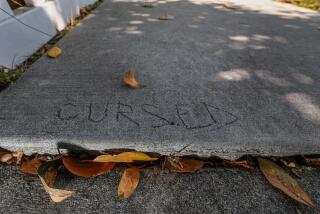Op-Ed: Will traffic NIMBYs ruin Waze?
- Share via
Twenty-five years ago, before GPS and smartphones, Richard Schwadel and I co-wrote a book called “L.A. Shortcuts: The Guidebook for Drivers Who Hate to Wait,” born out of a bet as to the fastest route to LAX. You could say we were the original Wazers. We had our 15 minutes of fame, made a little money and had an easy conversation starter at parties.
We also took a lot of flak from every homeowner’s association and well-to-do neighborhood from Pacific Palisades to the Hollywood Hills, upset that the hoi polloi were passing in front of their properties to avoid traffic. And it wasn’t very long before that flak turned into communities erecting “no left turn” signs on some of our favorite shortcuts.
Shortly after the book was published, I was late for a meeting and turned onto Outpost from Mulholland Drive to avoid the dreaded Cahuenga Pass parking lot, and I was pulled over by one of L.A.’s finest. When I asked him what I had done, he said that “two idiots had written a shortcut book” and that it was no longer legal to use Outpost to go into Hollywood during certain hours. I told him that I was one of those idiots. He laughed and let me off with a warning.
Though I dodged a ticket, that traffic stop raised serious questions. How was it possible that a public street maintained with my tax dollars was no longer available to me? I wasn’t speeding. I wasn’t intoxicated. I had a valid license. It wasn’t my fault that homeowners didn’t look at a simple map or check the traffic patterns before they bought a house. Who were these people who had persuaded the government to give their private interests priority? What shortcut did they take every morning to get to work on time?
And by the way, it wasn’t like anybody with a house on Fountain or Willoughby Avenues was getting any traction on changing traffic patterns. I could still fly across town on those streets without getting pulled over.
A lot has changed in 2½ decades: The financial meltdown has vaporized the middle class, the notion of retirement has become a long-lost fantasy, and because of our love of fossil fuels, the ice sheets may soon turn your beachfront property into a water park. Traffic has gotten worse — and the traffic workarounds have gotten more sophisticated.
Waze, that brilliant smartphone app that uses input from millions of drivers to redirect you away from traffic trouble spots, is a quantum leap forward for those of us who want to keep our blood pressure down during the daily commute. I use it religiously.
But now, just like a quarter-century ago, homeowners are screaming “not in my backyard!” Or, more precisely, “not the street in front of my frontyard!” What’s worse, Los Angeles City Council members are listening.
Last week, Councilman Paul Krekorian said in a news release that “many blame Waze and other mobile apps because they divert drivers from major avenues onto small residential streets that aren’t designed to accommodate them, resulting in far greater congestion and traffic for residential neighborhoods.”
Not designed to accommodate them? He means that larger streets have certain safety features, such as signal lights, which some residential streets may lack. Fair enough. But can someone please show me a single street in Los Angeles adequately designed to accommodate the city’s traffic?
Krekorian introduced a motion to “reduce the impact of cut-through traffic that results from use of Waze,” and suggested that the app company could control traffic by regulating “the number of added daily trips” for some streets.
As Curbed Los Angeles put it, it sounds like Krekorian “wants the app to stop doing what it does.” He’s gunning at the very heart of Waze’s programming ingenuity, proposing to meddle with a private company’s software. Instead of “no left turn” signs, an algorithmic tweak would make left turns invisible.
Krekorian and other Waze critics — like the Brentwood woman who told the Associated Press recently that “the streets on the Westside are no longer a secret for locals, and people are angry” — should realize that the streets were never a secret meant for a select few and have been listed on maps at least since Wyatt Earp died here in 1929. Instead of blaming Waze, they should redirect their sense of entitlement to demand better mass-transit options that would reduce traffic for everyone.
As far as I’m concerned, as long you’re not speeding, drunk or under the age of 16, you should be able to drive any street you want at any time of day. The pitchforks and torches should come out and every citizen should tear down those protective traffic signs and have a big bonfire in front of City Hall.
And as long as I’m fantasizing, the creators of Waze shouldn’t be vilified but should get a Nobel Peace Prize for spreading traffic around, reducing carbon emissions and maintaining the sanity of drivers all over the world.
If you’re really that upset over the public service that Waze provides, spend a few thousand more dollars and do what I did: Buy a house on a cul-de-sac. Drivers on those streets are few and far between, and either lost or looking for a dog that bolted over the back fence.
Brian K. Roberts is a producer/director and writer who now commutes between Los Angeles and Toronto.
Follow the Opinion section on Twitter @latimesopinion and Facebook
More to Read
A cure for the common opinion
Get thought-provoking perspectives with our weekly newsletter.
You may occasionally receive promotional content from the Los Angeles Times.










